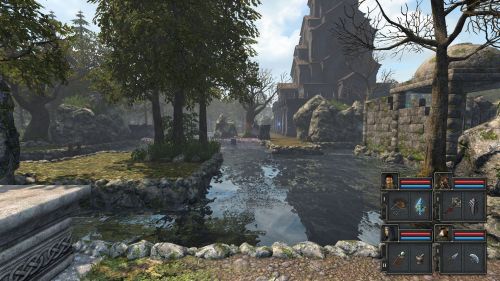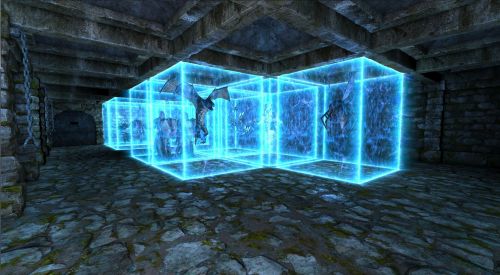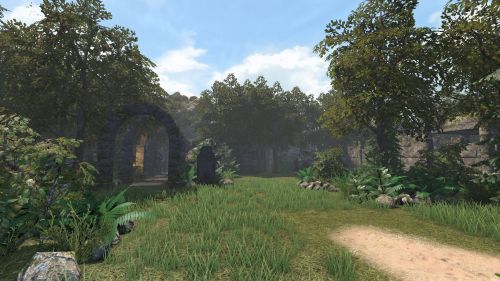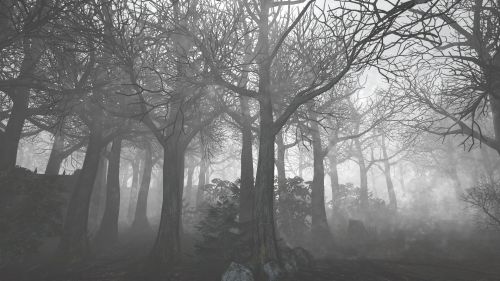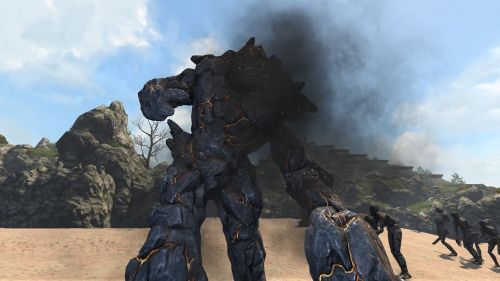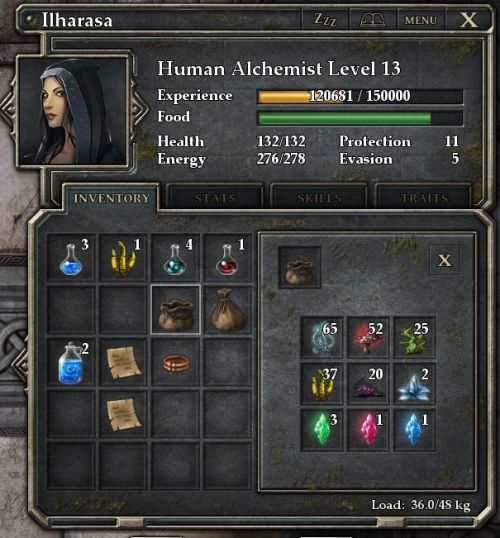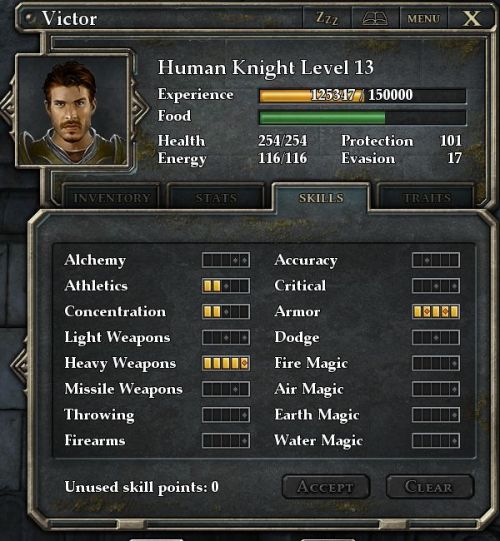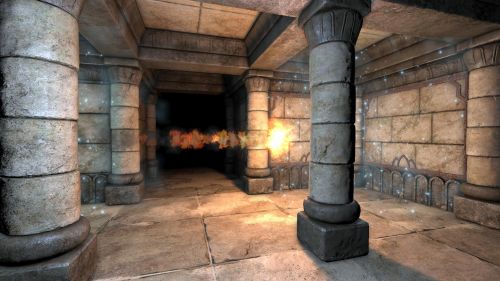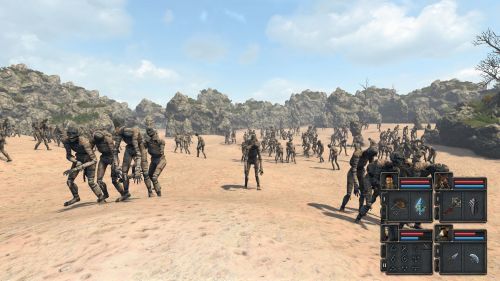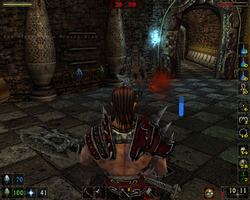RPG Codex Review: Legend of Grimrock II
RPG Codex Review: Legend of Grimrock II
Codex Review - posted by Crooked Bee on Sat 6 December 2014, 20:54:54
Tags: Almost Human Games; Legend of Grimrock 2It would be fair to say that, at the time of its release back in 2012, the success of the original Legend of Grimrock took not just any one of us, but everyone by surprise. A first person tile-based dungeon crawler in the vein of Dungeon Master? An RPG without BioWare-like epic plot or any NPCs to speak of, taking place in a single underground dungeon? What is this, Wizardry: Proving Grounds of Mad Overlord (which, as a prominent RPG designer told us, wouldn't even be considered an RPG if it was made today)?
And still, it proved to be a smashing success. Surprisingly, yet deservedly so.
However, when your first title is so successful, how do you go about making the sequel? Playing it safe, or expanding upon it? Thankfully, Almost Human went for the latter - while also acknowleding the limitations that are pretty much necessary to make a focused game. No NPCs or branching dialogue, just non-linear exploration. No C&C, just exploring the varied world not limited to a single dungeon anymore.
In this review, esteemed community member Decado elaborates on all that, and much more. So do read on, and enjoy.
[Review by Decado]
When the first Legend of Grimrock came out, it took me by surprise. I'm pretty sure the first I'd heard of it was on the Codex, a reliable go-to source for games that tend to slip the mind of the mainstream press. It was a pleasant surprise, precisely because it ticked for me all of the boxes that had not been ticked in a long time: A slow-paced, puzzle-based, RPG trek through a dangerous dungeon, with a good dose of combat, a fairly interactive environment, an interesting story, and an unapologetic learning curve.
The Legend of Grimrock II, then, is a continuation on these elements, and in almost all cases the sequel improves upon the original. There are some hiccups here and there, but for the most part Almost Human is well on their way towards building a strong, enduring franchise, but also a rock-solid approach to game design in general.
LoGII, like its predecessor, is a blobber. In RPG terms, this means that you move forward through the map, one square a time, with your party treated as a single entity (a blob). This mechanic has been around forever, and was originally designed to accommodate the limitations of older machines. With the resurgence of "nostalgic" game design, the mechanic is seeing more widespread use (Might and Magic X: Legacy, for example) but let's not confuse the nostalgia of talented developers like Almost Human who are making quality games with the nostalgia of talentless hipster hacks who want to make 8 bit games while eating responsibly sourced, farm to table cupcakes. In fact, I almost don't want to call it "nostalgia" at all, because there are plenty of reasons to use an older mechanic, and none of them need have anything to do with fond memories. As Almost Human shows with LoGII, those old mechanics are classics for a reason: they're awesome.
As a blobber, the LoG series sticks mostly to the tried and true mechanics of its predecessors. You move in squares, all turns happen in 90 degree increments, and your party attacks manually through right clicking on weapon/spell icons in the bottom corner. A free-look ability lets you move the camera any which way you want, but I can't say I ever used this much. The entire map is grid-based, which is another old and familiar way of doing business -- think the Bard's Tale, or the Eye of the Beholder series. All interaction with the environment is accomplished through a free floating mouse cursor, which allows you to do things like flip switches, pull levers, place items, or grab stuff. The interface is intuitive and easy to use. Some people have complained about the spell interface, but I honestly don't know what the big deal is. Using the mouse cursor, you "draw" a spell through the nine runes and, all the requirements being met, you cast it. Any spells you know will appear under your character sheet, a nice addition from the first game.
Like most RPGs, you are going to spend some time juggling numbers and stats. Health and energy operate as you would expect, and the hunger mechanic is back in a way that feels somewhat less drastic than in the previous game. Your characters need to eat, but on the Isle of Nex food is everywhere so it never feels like an intrusive system. In addition, you will keep tabs on resistances, damage scores, defensive ratings ala protection and evasion, and ammunition. Again, nothing revolutionary here, but all of it is solid, easy to understand, and well-integrated into the gameplay.
Since I mentioned the first one, we might as well get down to it and talk about the changes from LoG. One of the most burning "what if?" questions I had while playing LoG was "What if they could let us outside?" There is a long history in the CRPG genre of dungeon-delving games keeping you squarely in the dungeon, and LoG falls into this camp. It is not a bad thing. Since the dungeon is the entire gameworld, and since you never get a glimpse of anything overhead other than a stone ceiling, the game succeeds in creating a claustrophobic, almost depressing atmosphere. Using the free-look provided by the right mouse button helps to break up the monotony of one-square-at-a-time, but it's not like you're going to get a peek out of a window. You're in a tomb, bitch. Deal with it.
The biggest, most noticeable change in LoG is moving from one single, cramped dungeon to an entire overland map with multiple dungeons. Instead of traveling down, you travel out. Most of the dungeons in this new set-up are no more than three or four levels deep, but the proliferation of different dungeon types, combined with unique art for all of them, has created a real, diverse gameworld that feels different for each hole you decide to go down. The Crystal Caves, for example, feel like caves where dudes once toiled their lives away, mining for shitty blue crystals. Underground streams, pools, and hidden shafts add real heft to the exploration, and it is easy for the unskilled navigator to get lost, even with the aid of an improved minimap. And the addition of various terrain-heights both inside and out add depth to the exploration, and make for some pretty great puzzles. Graphically the game does very well. To continue with the Crystal Mines, eerie blue lights peek around corners and signal the locations of crystal outcroppings or the ever-valuable floating crystal thing. The animation is for the most part pretty damn good, and the creatures -- mummies, spiders, amazonian medusa broads who will petrify your whole party -- are crafted with painstaking detail. A great job on the art, all around.
Anyway, these changes the game world tone down the claustrophobic feeling, and seamlessly replace it with something else. Instead of feeling closed-in or pressed upon, the outdoor sections of the map feel exposed, even vulnerable. More than once I found my self hacking through some tough tree roots, only to find an enemy had snuck up behind me. Now granted, they weren't "sneaking" per se, and their element of surprise was owed more to my lack of attention. But the outdoor sections of LoGII have a way of lulling you into a sense of false security, as if simply because you can see trees and sunlight, walking fungus infections won't try to ram you up the butt with their poison gas clouds. They will. You have been warned. But still, there is a palpable sense of relief and freedom when, after spending four hours underground, you emerge from some rickety stairs into the bright sunlight, steps away from a sandy beach. It would be a vacation if giant rats weren't shooting you with flintlocks.
There are a lot of other, smaller changes to the gameplay this time around. Squaredancing your way through combat in LoG was practically a foolproof endeavor, and though I will cover this in more detail later, suffice it to say that combat is not that easy anymore. In addition, the skill trees have been revamped, the spell system optimized (though still underwhelming, sadly), alchemy expanded, weapon use made more complex, and some more good ideas thrown in for good measure. Oh, and you can play as a rat and fight a rat boss pirate, in case you're into that weird shit.
***
It seems inevitable that when a game gets a sequel, the sequel will have new mechanics, and LoGII is no exception. The skill system in LoGII is a definitely more streamlined than in its predecessor, but I'm not sure the new system is really that much better than the one it replaced.
LoG had a skill system that was too granular, something that the developers admitted when they set out to fix it. However, the new system is not much of an improvement if only because, like it's predecessor, it seems like there are too many "must have" skills. If you're going to play on hard, you need -- need! -- to spend a lot of points at least one weapon-related skill, and at least one defense-related skill, if you want your front line fighters to survive. You might think that a requirement to make your fighters tough and good with weapons is not that onerous, but the problem is in the execution. Dodge, for example, strikes me as a pretty useless skill to cultivate for your front lines. In fact, after screwing around with several different builds, the best solution I came up with was to max out heavy weapons, max out armor, and dump some points into athletics. There don't seem to be many alternatives. Because of the way the game calculates damage and hit-chance, it seems like damage mitigation (read: protection) will always trump evasion. And another thing: why do shields give a bonus to evasion, when protection seems like the much more sensible area? Think about it: if you have a heavily armored knight, a big-ass shield is not going to make him harder to hit, it is going to make him harder to damage. I'm glad to see that there are two defensive categories instead of one unified "armor class" mechanic, but right now evasion feels rather worthless. Just like it did in the first game.
The introduction of classes (Fighters, Barbarians, Alchemists, etc) was a nice touch, and they provide some bonuses/penalties that make the roleplaying feel consequential. Unfortunately, the weapon and armor system as described above cheapens some of these differences. Again, it doesn't matter if you have a fighter, a barbarian, or a knight on your front lines; common sense and a desire to survive will dictate that you pick no brainer skills. In LoGII, it seems like creativity is rewarded with a spider dick in the face.
In a similar vein, LoGII boasts an improved magic system but it feels like the real issues with the original magic system -- a lack of creativity -- have not really been addressed. For the most part, there are 3 or 4 spells for each of the elemental runes, and a few utility spells that are occasionally useful. The developers have attempted to create more diverse spellcasters by forcing you to invest in different schools: the meteor spell not only requires a maxed out fire magic, but also some points in air magic, etc This is a nice touch, but like the above noted issue with the skills mechanic, it can force you into some situations where you become a jack of all trades, when you really should focus on mastering a small few.
Alchemy is also much improved, perhaps overly so. In fact, I'll go ahead and say it: alchemy is OP'd. You can find a variety of ways to powergame the system on the Steam forums, so I will simply say this: bear potion. In addition, fully leveled alchemy skills let you make three (!) bombs instead of one, which is seriously over-the-top when you consider how plentiful the ingredients are. Finally, the Alchemist class allows you to grow ingredients in your inventory (!!) simply by walking around. Blood Caps (the ingredient used for healing) grow everywhere in abundance, but if you add the growth mechanic to this, their numbers get to be insane. At the end of the game I had 50 something of them in my inventory, and that was without me being stingy. I had similar amounts for other ingredients.
The revamping of the skill system required Almost Human to go back to the drawing board with their special attacks. You might recall that in LoG, special attacks procced on their own, through a seemingly random dice roll. They were nice perks to unlock in your weapon skill sets, but their randomization made them worthless for any kind of tactical use, as they were essentially just dumb luck. The change for LoGII makes these abilities weapon dependant, and allows you to control them yourself. So, for example, an axe can come with a special slash attack that ignores armor, but to activate it you must 1) have the appropriate level and 2) hold down the right mouse button for a few seconds 3) have enough energy. This means that you can't really spam these special attacks, which is a nice touch to prevent them from being op'd.
Finally, the addition of firearms to the mix ends up being a bit disappointing, mostly because they do not seem to be balanced very well. All of the handguns seem to do a paltry amount of damage when compared to their melee -- or even other ranged -- counterparts, and the cannon does not deliver the damage-bang for it's weight-cost-buck. I lugged around several cannon balls for hours, just waiting to find some boss creature worthy of having their face pulped, but I was pretty sorely let down by the amount of damage the cannon was able to do. In addition, the jam rate for those weapons make them so annoying, it only makes sense to use them if you take the Alchemist class (who gets a reduction in jam rates for firearms).
So to summarize the new skill system: it's alright. I am leery when developers opt to "streamline" systems, because that is usually a codeword for dumbing things down for filthy casuals. However, I'm pretty sure that Almost Human knows who their audience is, and their streamlining here is evidence that they put a lot of thought into what they were doing. My research indicates that most players will find the level cap around 15, which means you can max out three skills. On hard, and with the above discussion re: skills you sorta have to take if you want to survive, this doesn't give you a lot of wiggle room. This can be problem because sometimes there are special attacks that will require a few levels in Concentration, such as the Crystal Shield's "Heal" spell. If you're playing a knight on hard, you're likely dumping points into weapons, armor, and athletics so by the time you get the shield, similarly dumping a few points into Concentration just to be able to use the special ability of the shield seems like a mighty waste of precious points -- especially considering that Concentration doesn't really do much for a fighter-type in the grand scheme of things.
Okay, so fighters might not be so versatile, but what of the others? Since I spent a good chunk of time talking about the Alchemist, let's consider that class. They get the above mentioned bonuses with ingredients and firearms, so they feel tailor-made to be a bomb-throwing, pistol-shooting, hang-out-in-the-back-row kind of character. And let me tell you: this instinct is correct. Follow it! Don't do what I did, and make your alchemist your party magic user. Frustration and ass-kickings abound, trust me. I made the mistake of thinking "Hmm, alchemist . . . bombs, pistols . . . and fire!" I started dumping points into Fire magic like they were going on sale, but a strong magic user in Grimrock needs more than one element to be effective. You will likely need to focus on two elements, and you cannot ignore Concentration as a stat. Remember that 15 point upper limit? Well, you're about to smash your head into it.
Operating behind all of this is a racial category that should be immediately familiar to players of CRPGs. You can roll a human (good at everything, faster experience gain) to minotaur (strong, eats a lot), to lizard folks, giant creepy ass bugs, and a new race, the ratlings, who have a neat ability to gain extra ability points by eating enough cheese (yes, this is a thing). Like the classes, racial choices will blatantly suggest characters' roles, and unless you're feeling brave, it is best for the first-time player to take the hint. Minotaurs make great front-line fighters, ratlings are designed to be rogues or perhaps alchemists, and you will figure out the rest. Beyond these differences, race has little bearing on the play of the game itself.
In essence, then, LoGII is a game that relies heavily on traditional, conservative approaches to building characters. The classes will nudge you in a particular direction, and you are strongly encouraged to follow that direction if you want them to be the most effective. This is not a bad thing, especially in an old school dungeon crawler. I never got upset that my wizard couldn't use a two-handed sword in AD&D, and I'm not going to get upset that my knight makes a lousy potion brewer. Just be careful when deviating from the suggested path, and don't say you weren't warned.
As a full disclaimer, it could be that I just suck at the game, and other, better grognards will make creative choices and fly through the game because they are super cool dudes or whatever. That's fine. But my playthrough convinced me that a conservative approach ala swords and boards is the way to go.
***
The biggest complaint about LoG's combat was it's cheesabilty. It was almost impossible for you to not beat the toughest of opponents through what has become known as "Square Dancing." Provided you could funnel attackers into an area where they could only get to you one at a time, there is literally no enemy you cannot beat if you but have a little patience. If you have four squares in which to move, you can continually flank any creature by moving in a square around them, making combat terribly easy, if not terribly boring.
One could argue that this is sort of an inherent problem with the non-turn based blobber format, and one could be right. There was a lot of discussion and speculation, even on these very forums, on how AH could/should fix this issue, and I am happy to say that through a combination of more clever level design and better creature AI, it is a lot harder (though still not impossible) to square dance your way to victory.
Let's start with the level design. In LoGII, it felt like I was more apt to encounter enemies in narrow, one-square corridors with little to no room for maneuvering. Also, this time around AH have made better use of things like trap teleporters, puzzle-ish fights, hidden doors, and various other tricks in order to get you standing toe-to-toe with enemies. There is still a lot of moving around, but it is more about positioning for a way to prevent being flanked than it is about cheesing the fights. This works because creatures now have better AI, but also attacks that counter your flank attempts. Ogres will take sideways swipes if you try to flank, and some enemies can even hit you with their backs turned (thanks for crapping in my face, flying squid). So overall, combat is a decidedly riskier endeavor this time around. An injury system has been added, so some broken legs will prevent energy regeneration, or a head injury can give you an accuracy penalty, but these are easily fixed with a health potion (which you will have plenty of, remember) so while nice, it doesn't feel that important.
I've spent a lot of time talking about combat, and while it is well done and mostly satisfying, it is really only half -- perhaps even less than half -- of the game. LoGII shines when it comes to puzzles. This is where the game gets good, and serious, and downright difficult. This is, I suspect, where AH will lose many casual players. But that's okay. Screw em.
***
Before I get started, the huge caveat looming over everything I say here is an obvious one: some people will find these puzzles easy, and some will find them hard, but everyone can find them on the internet. How "hard" this game gets is really dependant upon how long you are willing to try something before you just google it. That said . . .
The puzzles in LoGII are masterful, and I don't use that word lightly. They come in all shapes, speeds and sizes. There are terrain puzzles, rune riddles, timing and dexterity tests, visual tricks, and some plain-old brain power demands. Each new area offers a plethora of obstacles, some requiring extensive involvement, and others a smatter of quick wit. You will climb ladders, rappel down pits, use teleporters and pressure plates, and at least in one instance rely on a trapped spider. On top of this, there are language puzzles to mull over, and you will stumble across the occasional hint on a rolled up scroll. Careful exploration will reveal scrolls that show the location of buried treasures, or hints for another part of the world, and it can feel incredibly rewarding to stumble across one of these only to actually use it later. I can't talk too much about them without giving them away, but I can say the puzzles in this game can be downright brutal if you don't pay attention.
AH have turned up the level of environmental interactivity, and it really shows in both the puzzles and the exploration. You can now equip a shovel and dig for buried treasure, and the different terrain heights make for some great moments, such as an Indiana Jones-esque leap into the abyss that ends with a sturdy magical bridge under your feet. Secret areas can be found by resting in certain spots, and gold keys and treasure await the intrepid canal diver. All of these mechanics work in harmony to not only spice up the normal game world travel, but the puzzles as well.
I have to point out: there were one or two puzzles that, in retrospect, seem particularly unfair. A hard puzzle is one thing, but a hard puzzle with no clues -- or worse, no indication that you're in a puzzle at all -- can be infuriating. And more than once I ran into game-stopping puzzles, e.g. things you had to figure out to proceed, as opposed to figuring them out for a hidden item or some nice loot. These weren't absurdly difficult for me personally, but they would probably be showstoppers for some other people. Finally, sometimes the visuals themselves could make a puzzle difficult. It is hard to know that you should throw a rock onto yonder pressure plate if you can't see the goddamn thing. And I don't know about you, but I don't have a bunch of free rocks to be throwing around. Rocks don't grow on trees, for chrissake.
The only other big hiccup in the game is the navigation. LoGII is a pretty big world, and even the improved minimap cannot fix the lack of narrative direction. You eventually figure out you're supposed to be collecting these floating crystals, and you get pushed towards a foreboding castle that somehow requires all of these things to enter, but that's it. Some scattered, smart-assed notes from a hooded jerk-off are all you really get by way of instructions. Now, I don't want my hand to be held the whole way through, and I suspect most people playing this game don't want that either. But the lack of a journal or some kind of overarching story besides "You're stuck on this island!" presents a big hole in the presentation, especially because LoGII is such a huge game. In the first game, you were limited to a certain number of squares per dungeon, and you always knew you were heading down so, getting lost was virtually impossible. The second game, with its huge outdoor maps and multiple connection points between areas, requires a more robust framework. I like wandering around, but I don't like wandering around because I don't know what the hell else to do.
But these are all minor complaints, and adventuring through the Isle of Nex will have you wondering why other developers aren't giving this model a try. Between the combat and the puzzles, you are dealing with a deviously crafted game-world that seeks to kill you at every turn, with precious few moments of actual rest available. Story-wise, the game doesn't break any new ground, with a twist at the end that will surprise no one and a shopworn reliance on the "four elements" trope. But, the plot is just engaging enough to keep you trampling through forests, swamps, caves and deserts. The letter dropping, hooded figure is always just out of reach, and a leprechaun (yeah, I know) is there to taunt you when things start to slow down.
In short, I haven't been addicted to a game like this in a long, long time. My praise might be too flowing, too fulsome for a place like the Codex, but I have to hand it to the guys at Almost Human: this is a terrific achievement, and to top it all off it wasn't crowd-funded. The developers are demonstrating to the world that you can make these old-school, dungeon-crawling experiences and if done right, actually make a profit. I would say that the game has wide appeal, and I assume the developers certainly hope it does, but honestly the puzzles will probably turn the more casual players off.
When you put it all together, you get a hell of game. Challenging combat, an interesting skills mechanic, great visuals, terrific music, intelligent level design, and an overall feel for developing a living, breathing, dangerous world, puts Legend of Grimrock II quite high on my list of favorite RPGs. I will have to play it a few more times to be sure where I rank it, but it is probably in my top five of the last 15 years. Which means I will have to move Dragon Age II off of my list.
And still, it proved to be a smashing success. Surprisingly, yet deservedly so.
However, when your first title is so successful, how do you go about making the sequel? Playing it safe, or expanding upon it? Thankfully, Almost Human went for the latter - while also acknowleding the limitations that are pretty much necessary to make a focused game. No NPCs or branching dialogue, just non-linear exploration. No C&C, just exploring the varied world not limited to a single dungeon anymore.
In this review, esteemed community member Decado elaborates on all that, and much more. So do read on, and enjoy.
[Review by Decado]
When the first Legend of Grimrock came out, it took me by surprise. I'm pretty sure the first I'd heard of it was on the Codex, a reliable go-to source for games that tend to slip the mind of the mainstream press. It was a pleasant surprise, precisely because it ticked for me all of the boxes that had not been ticked in a long time: A slow-paced, puzzle-based, RPG trek through a dangerous dungeon, with a good dose of combat, a fairly interactive environment, an interesting story, and an unapologetic learning curve.
The Legend of Grimrock II, then, is a continuation on these elements, and in almost all cases the sequel improves upon the original. There are some hiccups here and there, but for the most part Almost Human is well on their way towards building a strong, enduring franchise, but also a rock-solid approach to game design in general.
LoGII, like its predecessor, is a blobber. In RPG terms, this means that you move forward through the map, one square a time, with your party treated as a single entity (a blob). This mechanic has been around forever, and was originally designed to accommodate the limitations of older machines. With the resurgence of "nostalgic" game design, the mechanic is seeing more widespread use (Might and Magic X: Legacy, for example) but let's not confuse the nostalgia of talented developers like Almost Human who are making quality games with the nostalgia of talentless hipster hacks who want to make 8 bit games while eating responsibly sourced, farm to table cupcakes. In fact, I almost don't want to call it "nostalgia" at all, because there are plenty of reasons to use an older mechanic, and none of them need have anything to do with fond memories. As Almost Human shows with LoGII, those old mechanics are classics for a reason: they're awesome.
As a blobber, the LoG series sticks mostly to the tried and true mechanics of its predecessors. You move in squares, all turns happen in 90 degree increments, and your party attacks manually through right clicking on weapon/spell icons in the bottom corner. A free-look ability lets you move the camera any which way you want, but I can't say I ever used this much. The entire map is grid-based, which is another old and familiar way of doing business -- think the Bard's Tale, or the Eye of the Beholder series. All interaction with the environment is accomplished through a free floating mouse cursor, which allows you to do things like flip switches, pull levers, place items, or grab stuff. The interface is intuitive and easy to use. Some people have complained about the spell interface, but I honestly don't know what the big deal is. Using the mouse cursor, you "draw" a spell through the nine runes and, all the requirements being met, you cast it. Any spells you know will appear under your character sheet, a nice addition from the first game.
Like most RPGs, you are going to spend some time juggling numbers and stats. Health and energy operate as you would expect, and the hunger mechanic is back in a way that feels somewhat less drastic than in the previous game. Your characters need to eat, but on the Isle of Nex food is everywhere so it never feels like an intrusive system. In addition, you will keep tabs on resistances, damage scores, defensive ratings ala protection and evasion, and ammunition. Again, nothing revolutionary here, but all of it is solid, easy to understand, and well-integrated into the gameplay.
Since I mentioned the first one, we might as well get down to it and talk about the changes from LoG. One of the most burning "what if?" questions I had while playing LoG was "What if they could let us outside?" There is a long history in the CRPG genre of dungeon-delving games keeping you squarely in the dungeon, and LoG falls into this camp. It is not a bad thing. Since the dungeon is the entire gameworld, and since you never get a glimpse of anything overhead other than a stone ceiling, the game succeeds in creating a claustrophobic, almost depressing atmosphere. Using the free-look provided by the right mouse button helps to break up the monotony of one-square-at-a-time, but it's not like you're going to get a peek out of a window. You're in a tomb, bitch. Deal with it.
The biggest, most noticeable change in LoG is moving from one single, cramped dungeon to an entire overland map with multiple dungeons. Instead of traveling down, you travel out. Most of the dungeons in this new set-up are no more than three or four levels deep, but the proliferation of different dungeon types, combined with unique art for all of them, has created a real, diverse gameworld that feels different for each hole you decide to go down. The Crystal Caves, for example, feel like caves where dudes once toiled their lives away, mining for shitty blue crystals. Underground streams, pools, and hidden shafts add real heft to the exploration, and it is easy for the unskilled navigator to get lost, even with the aid of an improved minimap. And the addition of various terrain-heights both inside and out add depth to the exploration, and make for some pretty great puzzles. Graphically the game does very well. To continue with the Crystal Mines, eerie blue lights peek around corners and signal the locations of crystal outcroppings or the ever-valuable floating crystal thing. The animation is for the most part pretty damn good, and the creatures -- mummies, spiders, amazonian medusa broads who will petrify your whole party -- are crafted with painstaking detail. A great job on the art, all around.
Anyway, these changes the game world tone down the claustrophobic feeling, and seamlessly replace it with something else. Instead of feeling closed-in or pressed upon, the outdoor sections of the map feel exposed, even vulnerable. More than once I found my self hacking through some tough tree roots, only to find an enemy had snuck up behind me. Now granted, they weren't "sneaking" per se, and their element of surprise was owed more to my lack of attention. But the outdoor sections of LoGII have a way of lulling you into a sense of false security, as if simply because you can see trees and sunlight, walking fungus infections won't try to ram you up the butt with their poison gas clouds. They will. You have been warned. But still, there is a palpable sense of relief and freedom when, after spending four hours underground, you emerge from some rickety stairs into the bright sunlight, steps away from a sandy beach. It would be a vacation if giant rats weren't shooting you with flintlocks.
There are a lot of other, smaller changes to the gameplay this time around. Squaredancing your way through combat in LoG was practically a foolproof endeavor, and though I will cover this in more detail later, suffice it to say that combat is not that easy anymore. In addition, the skill trees have been revamped, the spell system optimized (though still underwhelming, sadly), alchemy expanded, weapon use made more complex, and some more good ideas thrown in for good measure. Oh, and you can play as a rat and fight a rat boss pirate, in case you're into that weird shit.
***
It seems inevitable that when a game gets a sequel, the sequel will have new mechanics, and LoGII is no exception. The skill system in LoGII is a definitely more streamlined than in its predecessor, but I'm not sure the new system is really that much better than the one it replaced.
LoG had a skill system that was too granular, something that the developers admitted when they set out to fix it. However, the new system is not much of an improvement if only because, like it's predecessor, it seems like there are too many "must have" skills. If you're going to play on hard, you need -- need! -- to spend a lot of points at least one weapon-related skill, and at least one defense-related skill, if you want your front line fighters to survive. You might think that a requirement to make your fighters tough and good with weapons is not that onerous, but the problem is in the execution. Dodge, for example, strikes me as a pretty useless skill to cultivate for your front lines. In fact, after screwing around with several different builds, the best solution I came up with was to max out heavy weapons, max out armor, and dump some points into athletics. There don't seem to be many alternatives. Because of the way the game calculates damage and hit-chance, it seems like damage mitigation (read: protection) will always trump evasion. And another thing: why do shields give a bonus to evasion, when protection seems like the much more sensible area? Think about it: if you have a heavily armored knight, a big-ass shield is not going to make him harder to hit, it is going to make him harder to damage. I'm glad to see that there are two defensive categories instead of one unified "armor class" mechanic, but right now evasion feels rather worthless. Just like it did in the first game.
The introduction of classes (Fighters, Barbarians, Alchemists, etc) was a nice touch, and they provide some bonuses/penalties that make the roleplaying feel consequential. Unfortunately, the weapon and armor system as described above cheapens some of these differences. Again, it doesn't matter if you have a fighter, a barbarian, or a knight on your front lines; common sense and a desire to survive will dictate that you pick no brainer skills. In LoGII, it seems like creativity is rewarded with a spider dick in the face.
In a similar vein, LoGII boasts an improved magic system but it feels like the real issues with the original magic system -- a lack of creativity -- have not really been addressed. For the most part, there are 3 or 4 spells for each of the elemental runes, and a few utility spells that are occasionally useful. The developers have attempted to create more diverse spellcasters by forcing you to invest in different schools: the meteor spell not only requires a maxed out fire magic, but also some points in air magic, etc This is a nice touch, but like the above noted issue with the skills mechanic, it can force you into some situations where you become a jack of all trades, when you really should focus on mastering a small few.
Alchemy is also much improved, perhaps overly so. In fact, I'll go ahead and say it: alchemy is OP'd. You can find a variety of ways to powergame the system on the Steam forums, so I will simply say this: bear potion. In addition, fully leveled alchemy skills let you make three (!) bombs instead of one, which is seriously over-the-top when you consider how plentiful the ingredients are. Finally, the Alchemist class allows you to grow ingredients in your inventory (!!) simply by walking around. Blood Caps (the ingredient used for healing) grow everywhere in abundance, but if you add the growth mechanic to this, their numbers get to be insane. At the end of the game I had 50 something of them in my inventory, and that was without me being stingy. I had similar amounts for other ingredients.
The revamping of the skill system required Almost Human to go back to the drawing board with their special attacks. You might recall that in LoG, special attacks procced on their own, through a seemingly random dice roll. They were nice perks to unlock in your weapon skill sets, but their randomization made them worthless for any kind of tactical use, as they were essentially just dumb luck. The change for LoGII makes these abilities weapon dependant, and allows you to control them yourself. So, for example, an axe can come with a special slash attack that ignores armor, but to activate it you must 1) have the appropriate level and 2) hold down the right mouse button for a few seconds 3) have enough energy. This means that you can't really spam these special attacks, which is a nice touch to prevent them from being op'd.
Finally, the addition of firearms to the mix ends up being a bit disappointing, mostly because they do not seem to be balanced very well. All of the handguns seem to do a paltry amount of damage when compared to their melee -- or even other ranged -- counterparts, and the cannon does not deliver the damage-bang for it's weight-cost-buck. I lugged around several cannon balls for hours, just waiting to find some boss creature worthy of having their face pulped, but I was pretty sorely let down by the amount of damage the cannon was able to do. In addition, the jam rate for those weapons make them so annoying, it only makes sense to use them if you take the Alchemist class (who gets a reduction in jam rates for firearms).
So to summarize the new skill system: it's alright. I am leery when developers opt to "streamline" systems, because that is usually a codeword for dumbing things down for filthy casuals. However, I'm pretty sure that Almost Human knows who their audience is, and their streamlining here is evidence that they put a lot of thought into what they were doing. My research indicates that most players will find the level cap around 15, which means you can max out three skills. On hard, and with the above discussion re: skills you sorta have to take if you want to survive, this doesn't give you a lot of wiggle room. This can be problem because sometimes there are special attacks that will require a few levels in Concentration, such as the Crystal Shield's "Heal" spell. If you're playing a knight on hard, you're likely dumping points into weapons, armor, and athletics so by the time you get the shield, similarly dumping a few points into Concentration just to be able to use the special ability of the shield seems like a mighty waste of precious points -- especially considering that Concentration doesn't really do much for a fighter-type in the grand scheme of things.
Okay, so fighters might not be so versatile, but what of the others? Since I spent a good chunk of time talking about the Alchemist, let's consider that class. They get the above mentioned bonuses with ingredients and firearms, so they feel tailor-made to be a bomb-throwing, pistol-shooting, hang-out-in-the-back-row kind of character. And let me tell you: this instinct is correct. Follow it! Don't do what I did, and make your alchemist your party magic user. Frustration and ass-kickings abound, trust me. I made the mistake of thinking "Hmm, alchemist . . . bombs, pistols . . . and fire!" I started dumping points into Fire magic like they were going on sale, but a strong magic user in Grimrock needs more than one element to be effective. You will likely need to focus on two elements, and you cannot ignore Concentration as a stat. Remember that 15 point upper limit? Well, you're about to smash your head into it.
Operating behind all of this is a racial category that should be immediately familiar to players of CRPGs. You can roll a human (good at everything, faster experience gain) to minotaur (strong, eats a lot), to lizard folks, giant creepy ass bugs, and a new race, the ratlings, who have a neat ability to gain extra ability points by eating enough cheese (yes, this is a thing). Like the classes, racial choices will blatantly suggest characters' roles, and unless you're feeling brave, it is best for the first-time player to take the hint. Minotaurs make great front-line fighters, ratlings are designed to be rogues or perhaps alchemists, and you will figure out the rest. Beyond these differences, race has little bearing on the play of the game itself.
In essence, then, LoGII is a game that relies heavily on traditional, conservative approaches to building characters. The classes will nudge you in a particular direction, and you are strongly encouraged to follow that direction if you want them to be the most effective. This is not a bad thing, especially in an old school dungeon crawler. I never got upset that my wizard couldn't use a two-handed sword in AD&D, and I'm not going to get upset that my knight makes a lousy potion brewer. Just be careful when deviating from the suggested path, and don't say you weren't warned.
As a full disclaimer, it could be that I just suck at the game, and other, better grognards will make creative choices and fly through the game because they are super cool dudes or whatever. That's fine. But my playthrough convinced me that a conservative approach ala swords and boards is the way to go.
***
The biggest complaint about LoG's combat was it's cheesabilty. It was almost impossible for you to not beat the toughest of opponents through what has become known as "Square Dancing." Provided you could funnel attackers into an area where they could only get to you one at a time, there is literally no enemy you cannot beat if you but have a little patience. If you have four squares in which to move, you can continually flank any creature by moving in a square around them, making combat terribly easy, if not terribly boring.
One could argue that this is sort of an inherent problem with the non-turn based blobber format, and one could be right. There was a lot of discussion and speculation, even on these very forums, on how AH could/should fix this issue, and I am happy to say that through a combination of more clever level design and better creature AI, it is a lot harder (though still not impossible) to square dance your way to victory.
Let's start with the level design. In LoGII, it felt like I was more apt to encounter enemies in narrow, one-square corridors with little to no room for maneuvering. Also, this time around AH have made better use of things like trap teleporters, puzzle-ish fights, hidden doors, and various other tricks in order to get you standing toe-to-toe with enemies. There is still a lot of moving around, but it is more about positioning for a way to prevent being flanked than it is about cheesing the fights. This works because creatures now have better AI, but also attacks that counter your flank attempts. Ogres will take sideways swipes if you try to flank, and some enemies can even hit you with their backs turned (thanks for crapping in my face, flying squid). So overall, combat is a decidedly riskier endeavor this time around. An injury system has been added, so some broken legs will prevent energy regeneration, or a head injury can give you an accuracy penalty, but these are easily fixed with a health potion (which you will have plenty of, remember) so while nice, it doesn't feel that important.
I've spent a lot of time talking about combat, and while it is well done and mostly satisfying, it is really only half -- perhaps even less than half -- of the game. LoGII shines when it comes to puzzles. This is where the game gets good, and serious, and downright difficult. This is, I suspect, where AH will lose many casual players. But that's okay. Screw em.
***
Before I get started, the huge caveat looming over everything I say here is an obvious one: some people will find these puzzles easy, and some will find them hard, but everyone can find them on the internet. How "hard" this game gets is really dependant upon how long you are willing to try something before you just google it. That said . . .
The puzzles in LoGII are masterful, and I don't use that word lightly. They come in all shapes, speeds and sizes. There are terrain puzzles, rune riddles, timing and dexterity tests, visual tricks, and some plain-old brain power demands. Each new area offers a plethora of obstacles, some requiring extensive involvement, and others a smatter of quick wit. You will climb ladders, rappel down pits, use teleporters and pressure plates, and at least in one instance rely on a trapped spider. On top of this, there are language puzzles to mull over, and you will stumble across the occasional hint on a rolled up scroll. Careful exploration will reveal scrolls that show the location of buried treasures, or hints for another part of the world, and it can feel incredibly rewarding to stumble across one of these only to actually use it later. I can't talk too much about them without giving them away, but I can say the puzzles in this game can be downright brutal if you don't pay attention.
AH have turned up the level of environmental interactivity, and it really shows in both the puzzles and the exploration. You can now equip a shovel and dig for buried treasure, and the different terrain heights make for some great moments, such as an Indiana Jones-esque leap into the abyss that ends with a sturdy magical bridge under your feet. Secret areas can be found by resting in certain spots, and gold keys and treasure await the intrepid canal diver. All of these mechanics work in harmony to not only spice up the normal game world travel, but the puzzles as well.
I have to point out: there were one or two puzzles that, in retrospect, seem particularly unfair. A hard puzzle is one thing, but a hard puzzle with no clues -- or worse, no indication that you're in a puzzle at all -- can be infuriating. And more than once I ran into game-stopping puzzles, e.g. things you had to figure out to proceed, as opposed to figuring them out for a hidden item or some nice loot. These weren't absurdly difficult for me personally, but they would probably be showstoppers for some other people. Finally, sometimes the visuals themselves could make a puzzle difficult. It is hard to know that you should throw a rock onto yonder pressure plate if you can't see the goddamn thing. And I don't know about you, but I don't have a bunch of free rocks to be throwing around. Rocks don't grow on trees, for chrissake.
The only other big hiccup in the game is the navigation. LoGII is a pretty big world, and even the improved minimap cannot fix the lack of narrative direction. You eventually figure out you're supposed to be collecting these floating crystals, and you get pushed towards a foreboding castle that somehow requires all of these things to enter, but that's it. Some scattered, smart-assed notes from a hooded jerk-off are all you really get by way of instructions. Now, I don't want my hand to be held the whole way through, and I suspect most people playing this game don't want that either. But the lack of a journal or some kind of overarching story besides "You're stuck on this island!" presents a big hole in the presentation, especially because LoGII is such a huge game. In the first game, you were limited to a certain number of squares per dungeon, and you always knew you were heading down so, getting lost was virtually impossible. The second game, with its huge outdoor maps and multiple connection points between areas, requires a more robust framework. I like wandering around, but I don't like wandering around because I don't know what the hell else to do.
But these are all minor complaints, and adventuring through the Isle of Nex will have you wondering why other developers aren't giving this model a try. Between the combat and the puzzles, you are dealing with a deviously crafted game-world that seeks to kill you at every turn, with precious few moments of actual rest available. Story-wise, the game doesn't break any new ground, with a twist at the end that will surprise no one and a shopworn reliance on the "four elements" trope. But, the plot is just engaging enough to keep you trampling through forests, swamps, caves and deserts. The letter dropping, hooded figure is always just out of reach, and a leprechaun (yeah, I know) is there to taunt you when things start to slow down.
In short, I haven't been addicted to a game like this in a long, long time. My praise might be too flowing, too fulsome for a place like the Codex, but I have to hand it to the guys at Almost Human: this is a terrific achievement, and to top it all off it wasn't crowd-funded. The developers are demonstrating to the world that you can make these old-school, dungeon-crawling experiences and if done right, actually make a profit. I would say that the game has wide appeal, and I assume the developers certainly hope it does, but honestly the puzzles will probably turn the more casual players off.
When you put it all together, you get a hell of game. Challenging combat, an interesting skills mechanic, great visuals, terrific music, intelligent level design, and an overall feel for developing a living, breathing, dangerous world, puts Legend of Grimrock II quite high on my list of favorite RPGs. I will have to play it a few more times to be sure where I rank it, but it is probably in my top five of the last 15 years. Which means I will have to move Dragon Age II off of my list.
There are 25 comments on RPG Codex Review: Legend of Grimrock II





